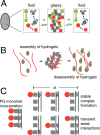Challenges and dreams: physics of weak interactions essential to life
- PMID: 25368424
- PMCID: PMC4230606
- DOI: 10.1091/mbc.E14-06-1035
Challenges and dreams: physics of weak interactions essential to life
Abstract
Biological systems display stunning capacities to self-organize. Moreover, their subcellular architectures are dynamic and responsive to changing needs and conditions. Key to these properties are manifold weak "quinary" interactions that have evolved to create specific spatial networks of macromolecules. These specific arrangements of molecules enable signals to be propagated over distances much greater than molecular dimensions, create phase separations that define functional regions in cells, and amplify cellular responses to changes in their environments. A major challenge is to develop biochemical tools and physical models to describe the panoply of weak interactions operating in cells. We also need better approaches to measure the biases in the spatial distributions of cellular macromolecules that result from the integrated action of multiple weak interactions. Partnerships between cell biologists, biochemists, and physicists are required to deploy these methods. Together these approaches will help us realize the dream of understanding the biological "glue" that sustains life at a molecular and cellular level.
© 2014 Chien and Gierasch. This article is distributed by The American Society for Cell Biology under license from the author(s). Two months after publication it is available to the public under an Attribution–Noncommercial–Share Alike 3.0 Unported Creative Commons License (http://creativecommons.org/licenses/by-nc-sa/3.0).
Figures

References
-
- Clegg J, Kell D, Knull H, Welch GR, Wilson J. Macromolecular interactions: tracing the roots. Trends Biochem Sci. 2001;26:91. - PubMed
MeSH terms
Substances
Grants and funding
LinkOut - more resources
Full Text Sources
Other Literature Sources

